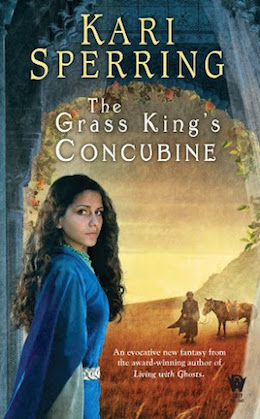Kari Sperring is, insofar as I’m concerned, a criminally under-appreciated writer. She has a rare gift for making worlds feel lived-in: her settings always feel as though they are very much larger, as though the story happens to focus on one character or another, but there are a dozen, a hundred others just outside the wings, living their lives in a city or in a place that really exists somewhere.
In The Grass King’s Concubine, she displays this gift for worldbuilding, not through people, but through a place: WorldBelow is an alien splendour, a fairytale world where The Grass King, the mythical ruler of spring and the harvest, lives with his court. In Sperring’s novel, the eponymous concubine has vanished alongside most of the court, and Aude, a woman dragged into the palace of WorldBelow, must figure out what went wrong while her husband Jehan goes after her. While Jehan’s strand of the story is familiar—a rescue of a loved one taken by supernatural beings—it’s Aude’s story that shines, and in particular, it’s the depiction of WorldBelow as she explores a haunted, empty palace that made a deep impression on me.
The Grass King’s palace is now deserted, with jut a handful of retainers left: it’s an odd and wondrous place, with the remnants of immense wealth—but also with a rising sense of weirdness Sperring catches through details: “a tall fountain in the shape of a woman, her script etched with more of that strange script,” “plasterwork pieced into a breathtaking filigree of… trees… clusters of fruit, grapes and peaches and the occasional, incongruous cogwheel, carved from jade and amber and warm quartz.”
The missing Concubine was linked to water, and water is a slow and growing obsession with Aude: most of the water channels in the palace have run dry, and only the Concubine’s chambers hold water. But, later on, Aude finds a bath: “a great alabaster basin cupped within a fine net of worked gold,” and cannot resist the temptation to enter it.
It’s at first a wonderful experience, one that links her to the missing Concubine, whose clothes Aude puts on: “when she offered her hands, the breeze dropped its admiring kisses on her palms.” But when Aude tries to exit, things turn sour, and the crystal bones of the former courtiers seek her to hold her there, drawn by her blood: “blood … sinking into her borrowed clothes, running down her spine and forearms and brow.” And gradually, her blood turns everything, even the clothes, alive: “strands of black embroidery… stretched out long suckers to the ground”—until the entire room becomes a trap, even the door “clinging to the wounds on her flank.”
The entire scene is a testament to how to evoke a sense of menace and dread which involves just one character, and no dialogue whatsoever: at first, the bath is a wonderful thing, an exhilarating experience for Aude, who’s been imprisoned and parched in a palace where water is a scarcity—her growing communion with what might be the ghost of the Concubine leads the reader to believe that, in fact, things will turn out all right—the magic rising in the room feels as thought it’s going to hold all the answers. It’s all the more horrifying when none of this actually happens, and when everything around Aude turns against her. I loved the small details: at first the crystal bones just seem to follow her bloody footsteps, and then more and more things come alive—the clothes are such a nice touch, a nightmarish occurrence—what would you do if your clothes tried to trip you up and bind you?
It’s also a comparatively long scene: four pages in the book. There’s a lot of advice out there on not wasting words, and I know as a beginning writer I imbibed altogether too much of it: there are times when you need space. When you need words, and building that kind of heavy, suffocating atmosphere is exactly the right time: Sperring gradually unspools the magic almost at the cusp of revelation, and then turns it into a fight for Aude’s life. The turning point is fast, just one sentence, a whiplash from dream to nightmare—and it’s the point at which both Aude and the reader realise that something is wrong.
So that’s the most awesome part of The Grass King’s Concubine—but quite honestly the entire book is awesome, with its unconventional and memorable WorldBelow, its lovely characters, and its talking, over-inquisitive ferrets (a narrow second place for most awesome in book), and of course its dreamlike and dangerous magic. You should check it out.
Aliette de Bodard is an engineer, a writer, and a keen amateur cook. Her love of mythology and history led her to speculative fiction early on. She is the author of The House of Shattered Wings and The House of Binding Thorns, the first two Dominion of the Fallen novels, plus numerous short stories, the Aztec noir trilogy Obsidian and Blood, and the award-nominated On a Red Station, Drifting, a space opera based on Vietnamese culture. She has won two Nebula Awards and a Locus Award.
is an engineer, a writer, and a keen amateur cook. Her love of mythology and history led her to speculative fiction early on. She is the author of The House of Shattered Wings and The House of Binding Thorns, the first two Dominion of the Fallen novels, plus numerous short stories, the Aztec noir trilogy Obsidian and Blood, and the award-nominated On a Red Station, Drifting, a space opera based on Vietnamese culture. She has won two Nebula Awards and a Locus Award.










